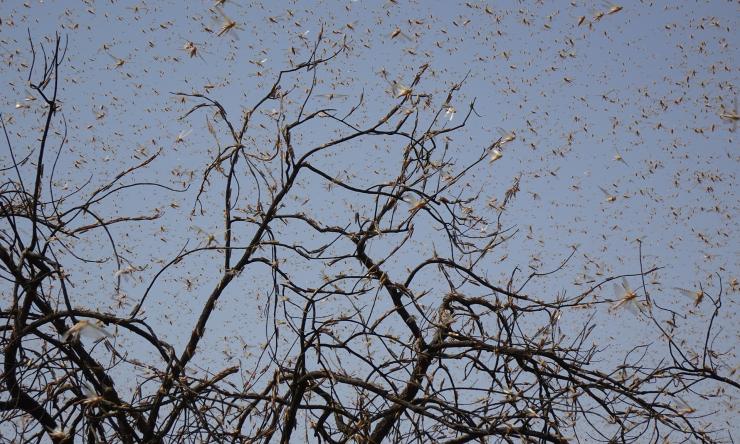New institute to study behavioral plasticity in locusts to support sustainable food systems
Locusts have a reputation of biblical proportions – when swarming they have been known to consume entire crops and devour grass for livestock. In doing so, they can destroy livelihoods for farmers and in some cases even destroy an entire community’s food supply. In small groups they are harmless, but as they swarm, devastation can follow.
That is why researchers from Baylor College of Medicine, together with researchers from Arizona State University, the University of California Davis, Texas A&M University and Washington University in St. Louis have created the Behavioral Plasticity Research Institute (BPRI) to understand the mechanisms behind locust swarms and migration and to develop effective methods of limiting the destruction they can leave behind.
The Behavioral Plasticity Research Institute
The cross-institutional, cross-disciplinary effort is led by Dr. Fabrizio Gabbiani, professor of neuroscience, and Dr. Herman Dierick, associate professor of molecular and human genetics, both at Baylor; Dr. Hojun Song, associate professor of entomology, and Dr. Spencer Behmer, professor of entomology, both with Texas A&M; and Dr. Arianne Cease, associate professor of sustainability and director of the Global Locust Initiative at Arizona State. The team with wide-ranging expertise also includes Drs. Erez Lieberman and Chenghang (Chuck) Zong at Baylor, Dr. Rick Overson at Arizona State, Dr. Stephen Rogers at UC Davis, Dr. Gregory Sword at Texas A&M AgriLife, and Dr. Barani Raman at Washington University. The BPRI is supported by a $12.5 million five-year grant from the National Science Foundation.
“Using cutting-edge technologies in research projects spanning from molecules to landscapes, the BPRI will greatly enhance our understanding of how grasshoppers transform into locusts – a phenomenon called locust phase polyphenism – and develop innovative solutions to manage locust plagues,” Gabbiani said. “With a commitment to improving diversity, inclusion and equity, the institute will train the next generation of integrative biologists who can efficiently navigate across disciplines to reach this goal.”
The institute will communicate groundbreaking research to the general public and the scientific community. By partnering with the Global Locust Initiative hosted at Arizona State, the institute plans to translate its scientific findings to real-world management with a goal of improving global food system sustainability.
“We'll be studying the factors that nudge individual locusts to join a larger group and the changes that follow,” Raman said. “The set of investigations proposed ranges from the molecular to the cellular to the ecological and evolutionary, and everything in between. Given the reports of massive, destructive locust swarms in many African and Asian countries this year, this is indeed a timely investigation of a well-reported, but not yet fully understood phenomenon."
“Every step of the way, we will ask the question of whether we are being inclusive and hearing all the perspectives,” Song said. “We need to work across subdisciplines and try to get at the big picture rather than focusing on little slices. I believe that by bringing all these people together, within the next five or 10 years, we can make amazing changes.”
Phase Polyphenism
Polyphenism is the phenomenon by which distinct phenotypes arise from environmental and other cues rather than genetic information during development. In the case of grasshoppers, alone they do not cause much damage. But in response to certain environmental and sensory cues they can change their behavior to become a cohesive group of swarming locusts which then can cause destruction.
Polyphenism is common in nature but to fully understand its mechanisms, maintenance and evolution, biological integration is needed. Studying this process also provides a way for researchers to understand how gene expression patterns and epigenetic regulation are linked to shifts in behavior, physiology and ecology that result in outbreaks, collective movement and mass migration.
This work will eventually lend itself to more than just insects. The information learned will help to understand how environment influences genetic makeup to shape behavior.
Research projects
Researchers with the BPRI plan to carry out 10 integrative research activities, using three locust and three non-swarming grasshopper species with varying degrees of plasticity. They will work with genomes, tissue-specific and time-resolved transcriptomes and epigenomes, as well as CRISPR/Cas9 and reverse genetics tools to understand the functional genetics of locust phase polyphenism.









